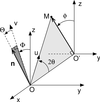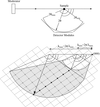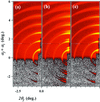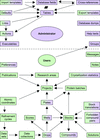issue contents
October 2006 issue

Cover illustration: Curvature mapping onto a surface drawn using the program Curvis. Courtesy of S. Piotto & R. Nesper [J. Appl. Cryst. (2005), 38, 223-227].
research papers
A rigorous measurement strategy for (X-ray) diffraction stress measurements at fixed penetration/information depths has been developed. Thereby errors caused by lack of penetration-depth control in traditional (X-ray) diffraction (sin2ψ) measurements have been annulled.
He+ implantation at doses from 9 × 1013 to 2.8 × 1016 ions cm−2, corresponding to a local concentration range of 40 to 11200 atomic parts per million (a.p.p.m.) averaged over the implantation depth of ∼1 µm, was used to study helium-bubble formation in borosilicate glass. The fitting of the scattering data yielded helium-bubble radii and helium-bubble volume fractions that vary from 5 to 15 Å and from 10−3 to 10−1, respectively, as the dose increased.
A new approach is proposed for X-ray dynamical diffraction theory in distorted crystals. The theory allows one to perform dynamical diffraction simulations between Bragg peaks for non-ideal crystals, using a simple approach of two distorted waves.
Functional titanium oxo-clusters Ti16O16(OEt)32−x(OPhCH=CH2)x with different numbers of styrenic groups, where x = 4 (tetra) and x = 16 (poly), have been synthesized and copolymerized with styrene. The influence of the number of functional groups borne by the oxo clusters on the structure of the resulting hybrid nanomaterials has been investigated by a combination of small-angle X-ray scattering, transmission electron microscopy and energy-filtering transmission electron microscopy
A method to determine the orientation distribution probability function of a population of nano-stacks from the dependence of a given diffraction peak's amplitude on the azimuthal angle is proposed. It is applied to two different types of orientational order observed in systems of sodium fluorohectorite clay particles.
A method for producing models from related sets of small-angle scattering data is presented that uses statistical methods to characterize the structural variability and interdependence between structural parameters.
A volume-fraction size distribution of hydrogen bubbles in aluminium was obtained from small-angle scattering data. The distribution was then adjusted using a size-dependent contrast to provide a more accurate description of the physical system.
A novel pattern-matching method for compositional depth profiling of polycrystalline thin films using grazing-incidence X-ray diffraction is proposed. As an example, the Cu and S gradients in a Cu(In,Ga)(S,Se)2 thin film are accurately refined.
An optimization-based pole-figure inversion method is presented that utilizes the orientation distribution function gradient for conditional control of the solution. The novel pole-figure inversion method, coined the hybrid  -seminorm minimization, is empirically shown to be versatile, general and robust in the presence of simulated experimental errors.
-seminorm minimization, is empirically shown to be versatile, general and robust in the presence of simulated experimental errors.
Open  access
access
 access
accessSXD, the single-crystal diffractometer at the ISIS spallation neutron source, CCLRC Rutherford Appleton Laboratory, is described.
The microstructure and twinning relationship between the martensitic variants in a newly developed Ni–Mn–Ga ferromagnetic shape memory alloy with non-modulated structure were experimentally investigated by high-resolution electron backscatter diffraction with a field emission scanning electron microscope.
The range of complexity for protein ab initio phasing is extended to more than 6000 non-hydrogen atoms in the asymmetric unit.
A three-dimensional image of the local neighbourhood of Mn atoms in a Ga1−xMnxAs (x = 0.02) layer has been obtained by using X-ray diffuse scattering holography.
Download citation


Download citation


The building units of the volcanic exhalation product chlorartinite consist of MgO6 octahedra forming 15-membered puckered rings which are interconnected by CO3 triangular moieties. The rings are stacked to form a honeycomb-like three-dimensional framework structure with large isolated channels, in which free chlorine atoms and disordered water molecules are located.
short communications
The robustness of a method to fold a two-dimensional powder diffraction pattern into a one-dimensional scan is demonstrated, along with its capability of efficiently tagging the pixels in a two-dimensional readout system by matching the ideal geometry of the detector to the real beam–sample–detector frame.
Grazing-incidence small-angle X-ray scattering patterns of a silver behenate composite film, which has a typical layered structure, are described.
computer programs
A computer program for initial analysis of fiber diffraction patterns is described.
The SHADE web server accepts an input structural model in CIF format. By combining a rigid-body analysis with estimates of internal atomic displacements, it returns an estimate of anisotropic displacement parameters of H atoms in the structure.
The crystallography data management system XtalBase is described. XtalBase helps designing, preparing, documenting and evaluating crystallization experiments and is a versatile tool for storing data associated with a macromolecular structure analysis.
laboratory notes
By the combination of energy spectroscopy and diffraction, using a wavelength-dispersive X-ray spectrometer mounted on a six-circle diffractometer and a CCD detector, simultaneous real-time data acquisition of both the momentum and the energy transfer was performed.
Crystallization from aqueous solution in a levitated droplet was observed by energy-dispersive X-ray diffraction using synchrotron radiation. It was found that crystallization during evaporation of the solvent can be easily followed in situ.
books received
Free 



 journal menu
journal menu









































